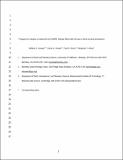Trapped Ar isotopes in meteorite ALH 84001 indicate Mars did not have a thick ancient atmosphere
Author(s)
Cassata, William S.; Shuster, David L.; Renne, Paul R.; Weiss, Benjamin P.
DownloadCassata_2012_open_access.pdf (6.331Mb)
PUBLISHER_CC
Publisher with Creative Commons License
Creative Commons Attribution
Terms of use
Metadata
Show full item recordAbstract
Water is not currently stable in liquid form on the martian surface due to the present mean atmospheric pressure of ∼7 mbar and mean global temperature of ∼220 K. However, geomorphic features and hydrated mineral assemblages suggest that Mars’ climate was once warmer and liquid water flowed on the surface. These observations may indicate a substantially more massive atmosphere in the past, but there have been few observational constraints on paleoatmospheric pressures. Here we show how the [superscript 40]Ar/[superscript 36]Ar ratios of trapped gases within martian meteorite ALH 84001 constrain paleoatmospheric pressure on Mars during the Noachian era [∼4.56–3.8 billion years (Ga)]. Our model indicates that atmospheric pressures did not exceed ∼1.5 bar during the first 400 million years (Ma) of the Noachian era, and were <400 mbar by 4.16 Ga. Such pressures of CO[subscript 2] are only sufficient to stabilize liquid water on Mars’ surface at low latitudes during seasonally warm periods. Other greenhouse gases like SO[superscript 2] and water vapor may have played an important role in intermittently stabilizing liquid water at higher latitudes following major volcanic eruptions or impact events.
Date issued
2012-05Department
Massachusetts Institute of Technology. Department of Earth, Atmospheric, and Planetary SciencesJournal
Icarus
Publisher
Elsevier
Citation
Cassata, William S. et al. “Trapped Ar Isotopes in Meteorite ALH 84001 Indicate Mars Did Not Have a Thick Ancient Atmosphere.” Icarus 221.1 (2012): 461–465.
Version: Author's final manuscript
ISSN
0019-1035